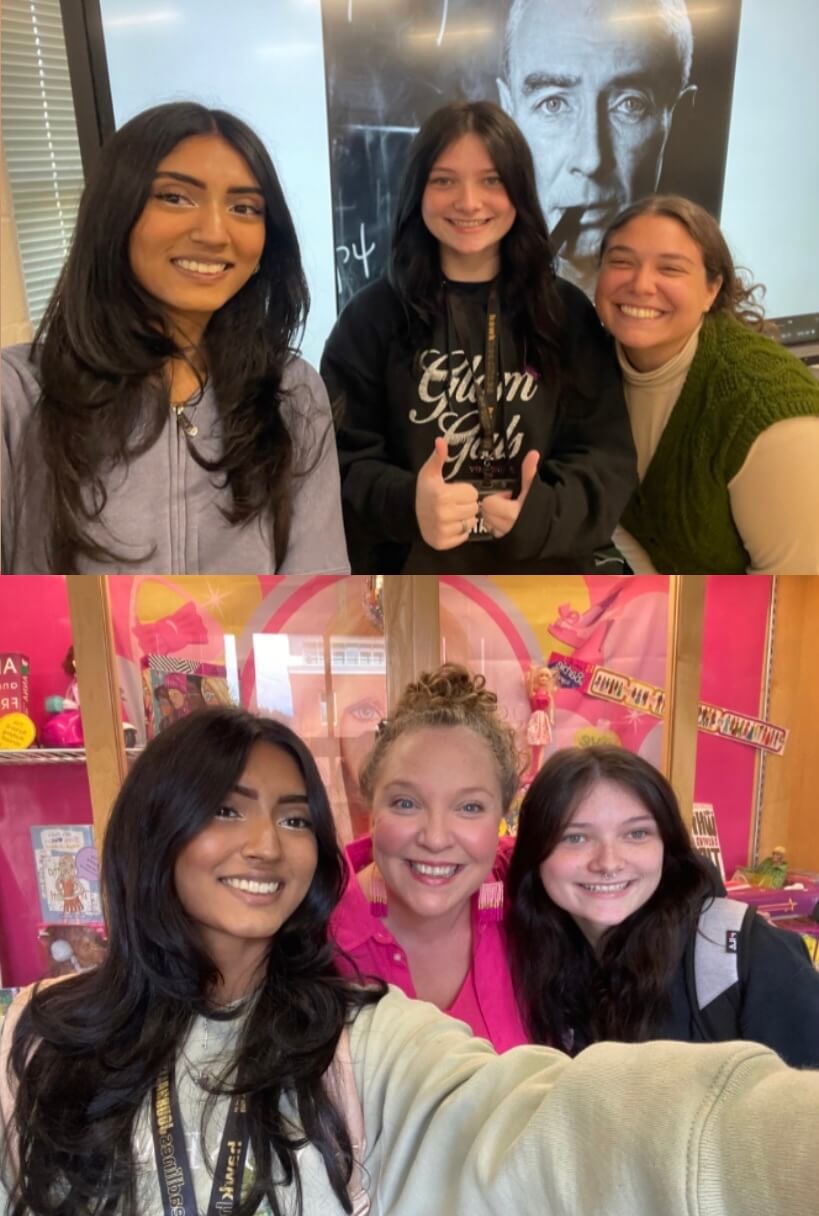Tensions rose to a head-to-head battle in the box office when the polar opposite movies, Barbie and Oppenheimer, released on the same day.
Barbie, is currently the highest grossing film in the U.S. lead by a female director. Greta Gerwig, broke records with the highly anticipated movie that brought the iconic franchise from our childhoods to life. Meghan Geary, Woodland Worldwide advisor, describes Gerwig’s approach to this task.
“She took so many risks with this film and didn’t just create a Hollywood sensational movie about a toy. She made such smart human compassionate choices,” stated Geary. “It managed to entertain while also pointing out some pretty important societal flaws,”
In Barbieland, gender roles are reversed. Women hold the power, and men are subservient. The movie takes it to the extreme, as the Kens feel inferior in comparison, and devote their lives to worshiping their Barbies.
And so you have probably already heard of the basic plot: Stereotypical Barbie (Margot Robbie), the leading star in Barbieland, experiences a crisis—flat feet. In order to repair the damages, she is sent on a mission to the real world with her long-term, long distance, low commitment, casual boyfriend, Ken (Ryan Gosling.) Barbie must find her human, and figure out why that Barbie’s emotions are causing her to malfunction. At last, she encounters Sasha who Barbie believes must be her person. But, to her dismay, Sasha hates Barbie, for the hypocritical ideals she seems to represent, leading Barbie to spiral. Overwhelmed with emotion in the real world, she begins to cry, a phenomenon that is oddly new to her.
There, Ken discovers the reality of patriarchy in the U.S., where men dominate society.
Barbie decides to bring Sasha and her mother back to Barbieland to show them how her society is opposite in the sense that women have power. There, they are shocked to discover that the Kens have taken over, filled with beliefs of toxic masculinity, and the sudden need to control. Barbieland has become the “Kendom,” and now it is up to the Barbies to “wake up” and regain authority.
Without spoiling, it can be said that the ending of Barbie was both heartfelt, but also comical.
“I like that [Gerwig] doubled down on that magical realism. And again, going back to the idea that Barbie can be anything, she sure does show us that at the end of the film.”
Remember: You are kenough <3
Oppenheimer, Barbie’ s rival, is a Christopher Nolan film about J. Robert Oppenheimer, the man who created the atomic bomb. The movie was inspired by Kai Bird and Martin J. Sherwin’s biography, American Prometheus: The Triumph and Tragedy of J. Robert Oppenheimer, a portrayal of Oppenheimer’s life. Jillian Jackman, a well respected history teacher, appreciated the historical representation.
“The movie itself is fairly accurate. All of the timeline events are correctly placed and all the themes of the movie are constant to what they would be at that time period.”
The story follows Oppenheimer, played by Cillian Murphy, diving deep into his personal and professional life. The movie takes us along his early adulthood, teaching career, his work on the atomic bomb, the anti-communist attacks he faced, and even his personal relationships.
Oppenheimer’s teaching career at Berkeley was successful, as they were building a center for the study of quantum physics. While teaching, it was confirmed that Germany had invaded Poland. This incited Oppenheimer and his friend, Ernest Lawrence, to find a solution using the newly invented particle accelerator to end the war. Their groundbreaking discoveries led Oppenheimer and Lawrence to play crucial roles in the creation of the atomic bomb.
Oppenheimer served as director of a lab in Los Alamos, New Mexico, where he and several others isolated themselves in order to scientifically solve how to harness nuclear power. Nolans film goes in depth about the decision-making process when creating a bomb that could destroy the world. All members of The Manhattan Project understood the risks of this task, although the overarching goal was to end the current war and prevent future ones.
Oppenheimer served as director of a lab in Los Alamos, New Mexico, where he and several others isolated themselves in order to scientifically solve how to harness nuclear power. Nolans film goes in depth about the decision-making process when creating a bomb that could destroy the world. All members of The Manhattan Project understood the risks of this task, although the overarching goal was to end the current war and prevent future ones.
“I think it kinda shows that at the end of the day Oppenheimer was a human being, who by no chance but his own made a decision that would alter the rest of the world. So that’s a huge undertaking, and I think that moment of solid reflection shows that one person can make a huge difference.”
This film raised awareness around the concern of atomic warfare and the consequences of it, by considering the perspective of the man who created it.
As far as the viral controversy, Jackman and Geary understood the hype,
“I did participate in Barbenheimer, opening day of both films, I did see Barbie before as an appetizer to Oppenheimer. I do think that both of the films are cinematic masterpieces that key into the power, once more, of people in society, and their choices. And how, you know, we shape the world we’re living in,” said Jackman.
“I am 100% interested in seeing Oppenheimer. We haven’t seen it yet, but would still really like to go see it in the theaters. And I didn ́t know there was a “feud”, like which ones “better”, I think they can both be amazing and excellent,” said Geary. “They can both be like the best films of the summer, because they are so different, and they center really important stories at their core. And they’re movies that we should all see, both of them,”



















